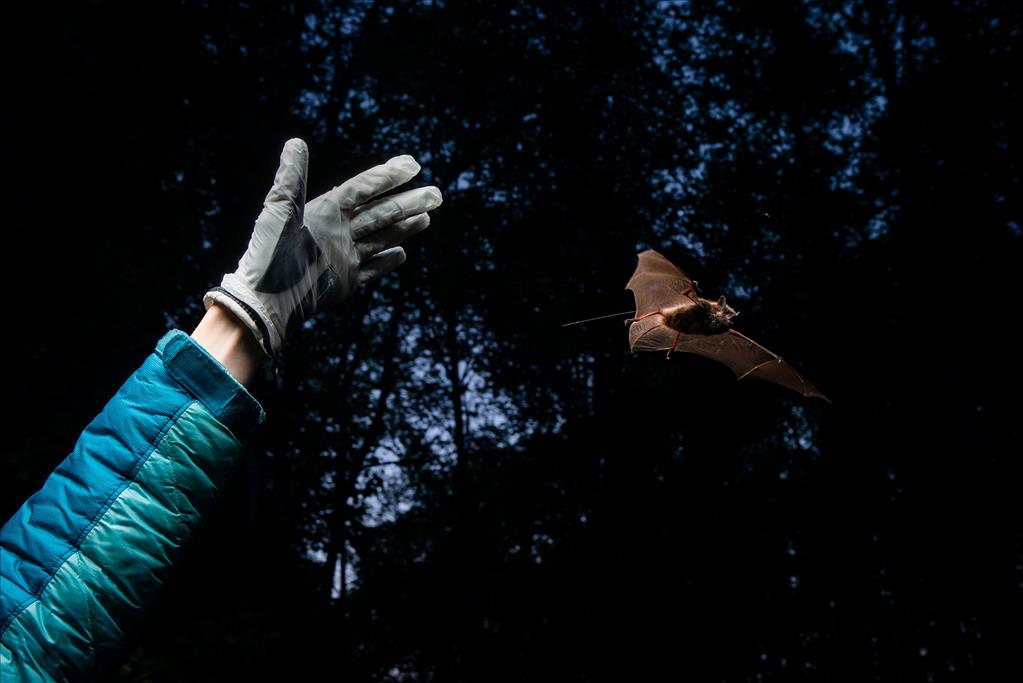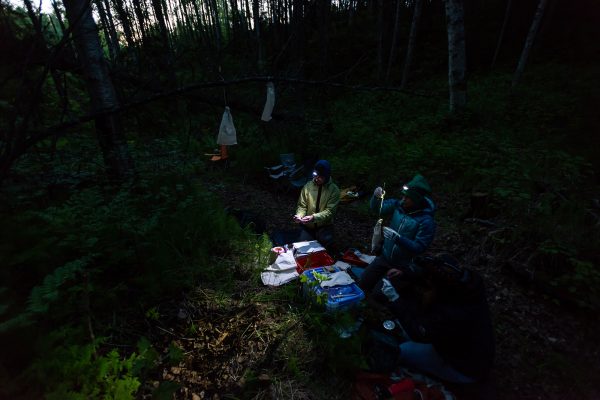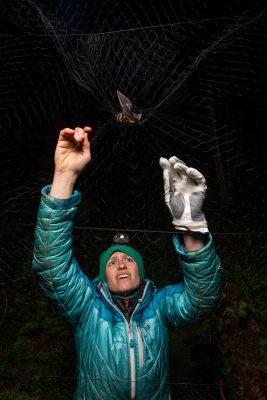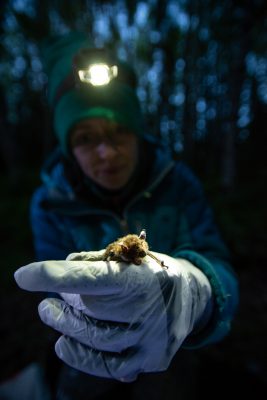How vulnerable are Alaska's bats to white-nose syndrome?
by Jess |

Jesika Reimer, assistant zoologist at UAA's Alaska Center for Conservation Science (ACCS), releases a little brown bat (Myotis lucifugus) after affixing a band and radio tag to it on Joint Base Elmendorf-Richardson (JBER) near Anchorage, Alaska. Researchers from ACCS and the Applied Environmental Research Center are working with DOD wildlife managers to determine where JBER bats roost and assess their potential vulnerability to white-nose syndrome. (Photo by James Evans / University of Alaska Anchorage)
In a state like Alaska, impressive large mammals like bears, moose and whales get a lot of our attention. At the other end of the gee-whiz spectrum are the amazing long-distance journeys made by migratory birds - some of them weighing just ounces - from around the globe to the north every spring.
Granted, these forms of nature are truly spectacular. So it's no surprise that the status of the little brown bat (Myotis lucifugus) may be less well known.
Over the last decade, white-nose syndrome (WNS), a disease affecting up to 11 species of hibernating bats, has been associated with extensive mortality starting on the East Coast and marching steadily west and north. Most recently, the fungus that causes WNS has been located in Wyoming, South Dakota and Washington state. Some researchers have predicted extinction of the little brown bat in the Northeast within two decades.
These developments have made information about Alaska bats - little brown bats are the most common here - much more urgent. Could migrating bats bring this devastation to Alaska? If our bats don't migrate, could Alaska become their last surviving refuge? If WNS were detected here, how would Alaska manage their habitat?
Monitoring on JBER
Alaska's lack of hard data is changing fast, and the University of Alaska Anchorage is part of that information network.
Alaskan and Canadian scientists from federal, state and university agencies recently formed a northern working group to gather and share important details on where these bats live, where they hibernate and whether they migrate or over-winter. A similar collaborative effort nationally is housed on the website whitenosesyndrome.org.
Alaska citizens contribute to local roost monitoring programs. Maps and details can be found at UAA's Alaska Center for Conservation Science (ACCS) and at the Alaska Department of Fish & Game Citizen Science Program site.
Specifically this summer, researchers from the Applied Environmental Research Center (AERC), a part of the UAA Business Enterprise Institute, and UAA's ACCS, are monitoring and tagging bats on Joint Base Elmendorf-Richardson (JBER).
The two-year assignment from JBER comes as the plight of the little brown bat gains momentum. The U.S. Fish and Wildlife Service (USFWS) is evaluating whether they warrant protection under the Endangered Species Act. The State of Alaska has identified all Alaska bats as Species of Greatest Conservation Need in their Wildlife Action Plan. This requires ongoing monitoring of bats, their hibernating behavior and habitat choices as a strategy to preserve their health.
"In this case, JBER is being proactive in wanting to identify potential habitat and potential roost sites for where bats occur," said Tracey Gotthardt of AERC, one of several scientists working on the project. The monitoring will allow scientists and land managers to essentially have their finger on the pulse of the health of bats at JBER. If or when WNS does arrive, its identity would be known quickly.
Military lands are largely protected from development and represent lots of diverse habitat for healthy wildlife. The Sikes Act, originally passed in 1960, ensures that these ecosystems are preserved while allowing military land to continue to meet military needs.
A night with the bats
During AERC's first year at JBER, researchers put out acoustic detectors in three different areas on base: at the end of the major runway, on the Eagle River flats and 2,500 feet up in the Chugach Mountains. Bats were detected at 70 percent of their sites to date.

Jesika Reimer, right, assistant zoologist at UAA's Alaska Center for Conservation Science (ACCS), and Tracey Gotthardt, left, director of the Applied Environmental Research Center (AERC), work together to band and radio tag little brown bats (Myotis lucifugus) on Joint Base Elmendorf-Richardson (JBER) near Anchorage, Alaska. (Photo by James Evans / University of Alaska Anchorage)
The acoustic detectors consist of a small programmable unit, housed in a metal ammunition box to discourage tampering by curious wildlife. A microphone attached to the detector is wrapped around a tree with a bungee cord at about chest height - the height bats are assumed to fly.
Bats use echolocation or sonar techniques to navigate and search for insects. Mosquitos are common, and recent evidence shows they also eat spiders. They produce a high pitched sound in their throat. Humans can only hear them by converting the sounds to lower frequencies, the job of the acoustic detectors.
The JBER work so far has delivered a few surprises.
"When I looked at the first year of data, there were a bunch of bats high up in the alpine areas," said Gotthardt, who joined the project at the beginning of year two. "My previous experience has been working with forest bats, so I was surprised to find so many bats in alpine areas where there are no tall trees."
Another surprise was how long the bats stuck around JBER. She said they found presence of bats nine out of the first 12 months of listening.
"It appears that they are hanging here, and that they may overwinter," Gotthardt said. "That's a mystery we have been trying to unfold for years. Where would they fly in the winter? To caves in Southeast Alaska? That's a far migration. Or, perhaps elsewhere in Southcentral Alaska. We just really don't know where they go."
Research in other mountainous states has found that some bats may overwinter in scree fields and rock crevices, sometimes even going solo. Snow cover could provide insulation. Avoiding caves and hibernating either alone or in smaller groups potentially could reduce or avoid the spread of WNS.
Besides placing acoustic detectors in up to 40 locations around JBER, the team plans to net and tag bats this summer and fall. They initiated that effort on June 1, and spent two nights - from sunset to sunrise - out in the JBER woods. They chose areas adjacent to water with hopes of capturing bats in transit to or from foraging areas.

Jesika Reimer, assistant zoologist at UAA's Alaska Center for Conservation Science (ACCS), retrieves a little brown bat (Myotis lucifugus) from a mist net so it can be banded and radio tagged on Joint Base Elmendorf-Richardson (JBER) near Anchorage, Alaska. (Photo by James Evans / University of Alaska Anchorage)
Acoustic detectors allowed the scientists to identify specific corridors bats were using. They hung mist nets among the birch and white spruce. The nets are mesh made of nylon or polyester suspended between two poles. Horizontal lines create loose, baggy pockets. When a bird or a bat hits the nearly invisible net, it falls into the pocket and becomes entangled.
At about 3:30 a.m. on the first night, several bats flew into the net all at once. One observer noted that bats had been seen flying higher than the nets before and after the successful capture. Jesika Reimer, an ACCS zoologist with extensive research and tagging experience, said that a single bat trapped in a net will often attract other bats, and hence the multiple captures all at once.
When they untangled the bats, they were surprised at what they'd found.
"We were capturing bats coming from a maternity colony, enroute to probably the wetlands complex for foraging," Gotthardt said. "We thought we would be capturing males, but we captured all pregnant females."
Bats have maternity colonies where pregnant females roost together. After tagging three, the team decided to postpone further work until August. Tiny arm bands with a unique ID number alert scientists if they re-capture the same bat. Using veterinary glue, they also attach a tiny transmitter between the shoulder blades. Typically, it will stay attached for 1-2 weeks, so scientists can track them.
"Our concern is they were very pregnant," Gotthardt said. "They are heavy, and they are eating. By placing a tag on their back, we would be adding more weight."
Besides, Gotthardt said, delaying the tagging until later in summer will give researchers more opportunity to follow them into the fall. "We've proven we can tag in a forested area. Now, we'll be looking at roosting sites around buildings."
Along with Gotthardt and Reimer, the team has two student technician/interns, Melissa Ferguson of Alaska Pacific University, and Richard McElmurry of UAA.
Why we should care
Little brown bats are an integral part of the ecosystem. They spend their summer evenings eating night-flying insects. At 7-10 grams and sized a little smaller than your clenched fist, these bats can eat half their weight each night in bugs. In agricultural areas, they help pollinate plants and eliminate pests. Their beneficial impact to agriculture and forestry systems in the Lower 48 is estimated at $4 billion.

Jesika Reimer, assistant zoologist at UAA's Alaska Center for Conservation Science (ACCS), holds a little brown bat (Myotis lucifugus) before affixing a band and radio tag to it on Joint Base Elmendorf-Richardson (JBER) near Anchorage, Alaska. (Photo by James Evans / University of Alaska Anchorage)
Scientists first identified the disease in New York in 2007. It's caused by a fungus, Pseudogymnoascus destructans, that infects bats as they hibernate in cool, moist caves in winter. That's when bats turn down their immune system to save energy while they "sleep." Bats have evolved over centuries to hibernate successfully in damp caves that are also rich environments for fungi, but scientists suspect that the fungus causing WNS has only recently been introduced to the United States. They are essentially hibernating in conditions that are also perfect for the growing fungus.
When they encounter WNS, fungus grows on a bat's nose, wings and ears, making it look fuzzy and white. One scientist likened it to what happens on that forgotten carton of cottage cheese in the back of your refrigerator, left to grow mold.
Infected bats "wake up" more often during hibernation, burning crucial fat reserves that can lead to starvation and death. They've also been spotted flying erratically outside in winter, probably looking for food.
Whole colonies can be wiped out in a winter. If infected bats make it out of hibernation, the white fuzz disappears because they groom it off. However, the disease may have already invaded skin tissue and left damage.
WNS affects hibernating bats, and about half of the 47 types of bats in the U.S. and Canada do hibernate. WNS has been found in 11 species in North America. Estimates are that close to six million bats across the U.S. have succumbed to WNS.
What would happen if little brown bats disappeared? We don't fully know. The effect on pest management and pollination in agriculture and forestry is well known. No effect has been detected in humans, but bats are considered a "sentinel species," meaning they can be used to detect risks to humans by providing advance warning of a danger, usually in terms of an environmental hazard.
Asked to describe WNS and its impact on bats in just a few words, David Blehert, a scientist with the USGS National Wildlife Health Center, starkly called it "an ecological disaster."
Written by Kathleen McCoy for UAA Office of Advancement
 "How vulnerable are Alaska's bats to white-nose syndrome?" is licensed under a Creative Commons Attribution-NonCommercial 4.0 International License.
"How vulnerable are Alaska's bats to white-nose syndrome?" is licensed under a Creative Commons Attribution-NonCommercial 4.0 International License.














